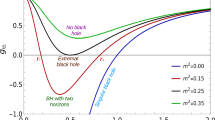Abstract
An analogy between the subtraction procedure in the Gibbons-Hawking Euclidean path integral approach to black hole thermodynamics and the Casimir effect is shown. Then a conjecture about a possible Casimir nature of the Gibbons-Hawking subtraction is made in the framework of Sakharov's induced gravity. In this framework it appears that the degrees of freedom involved in the Bekenstein-Hawking entropy can be naturally identified with zero-point modes of the matter fields. Some consequences of this view are sketched.
Similar content being viewed by others
REFERENCES
Gibbons, G. W., and Hawking, S. W. (1977). Phys. Rev. D15, 2752.
Hawking, S. W., Horowitz, G. T. (1996). Class. Quantum Grav. 13, 1478.
Hawking, S. W. (1979). In General Relativity: An Einstein Centenary Survey, S. W. Hawking and W. Israel, eds. (Cambridge University Press, Cambridge).
Birrell, N. D., and Davies, P. C. W. (1982). Quantum Fields in Curved Space (Cambridge University Press, Cambridge).
Grib, A. A., Mamayev, S. G., Mostepanenko, V. M. (1994). Vacuum Quantum Effects in Strong Fields (Friedmann Laboratory Publishing, St. Petersburg, Russia).
Plunien, G., Müller, B., and Greiner, W. (1986). Phys. Rep. 134, 87.
Plunien, G., Müller, B., and Greiner, W. (1987). Physica 145A, 202.
Dowker, J. S., and Kennedy, G. (1978). J. Phys. A11, 895.
Dowker, J. S., and Banach, R. (1978). J. Phys. A11, 2255.
DeWitt, B. S., Hart, C. H., and Isham, C. J. (1979). Physica 96A, 197.
Goncharov, Y. P., and Bytsenko, A. A. (1991). Class. Quantum Grav. 8, L211; (1986). Nucl. Phys. B271, 726.
Wolf, J. A. (1967). Spaces of constant Curvature (University of California Press, Berkeley).
Sakharov, A. D. (1968). Sov. Phys. Dok. 12, 1040.
Adler, S. L. (1990). In: Sakharov Remembered. A Tribute by Friends and Colleagues, S. D. Drell and S. P. Kapitza, eds. (American Institute of Physics, New York, in cooperation with the Physical Society of the USSR and Priroda Magazine).
Misner, C. W., Thorne, K. S. and Wheeler, J. A. (1973). Gravitation (W. H. Freeman, San Francisco).
See e.g. Adler, S. L. (1982). Rev. Mod. Phys. 54, 729.
Sakharov, A. D. (1976). Theor. Math. Phys. 23, 435.
Kennedy, G., Critchley, R., and Dowker, J. S. (1980). Ann. Phys. 125, 346.
Denardo, G., and Spallucci, E. (1982). Nuovo Cimento A69, 151.
Barvinsky, A. O., and Solodukhin, S. N. (1995). “Non-Minimal coupling, boundary terms and renormalization of the Einstein-Hilbert action and black hole entropy.” Preprint gr-qc/9512047.
Belgiorno, F., and Liberati, S. (1996). Phys. Rev. D53, 3172; Belgiorno, F., and Martellini, M. (1996). Phys. Rev. D53, 7073; Belgiorno, F., and Martellini, M. “Equilibrium Thermodynamics for Quantum Fields on a Black Hole Background”, to be published in the proceedings of the Second International Conference “Astronomy, Cosmoparticle Physics” — COSMION '96 (May 25–June 6, 1996, Moscow).
Gerlach, U. H. (1976). Phys. Rev. D14, 1479.
Jacobson, T. (1994). “Black Hole Entropy and Induced Gravity.” Preprint gr-qc/9404039.
Frolov, V. P., Fursaev, D. V., and Zelnikov, A. I. (1997). Nucl. Phys. B486, 339.
Bombelli, L., Koul, R. K., Lee, J., and Sorkin, R. (1986). Phys. Rev. D34, 373.
Bekenstein, J. D. (1994). “Do We Understand Black Hole Entropy?” Preprint gr-qc/9409015.
Wald, R. M. (1994). Quantum Field Theory in Curved Spacetime and Black Hole Thermodynamics (University of Chicago Press, Chicago and London).
Israel, W. (1976). Phys. Lett. A57, 107.
Barvinsky, A. O., Frolov, V. P., and Zelnikov, A. I. (1995). Phys. Rev. D51, 1741.
Takahashi, Y., Umezawa, H. (1975). Collective Phenomena 2, 55.
Sciama, D. W., Candelas, P., and Deutsch, D. (1981). Adv. Phys. 30, 327.
Sarmiento, A. (1991). In 'Vacuum Structure in Intense Fields, H. M. Fried and B. Muller (Plenum Press, New York); Sanchez, N., and Whiting, B. F. (1986). Phys. Rev. D34, 1056.
Jacobson, T. (1995). Phys. Rev. Lett. 75, 1260.
Hu, B. L. (1996). “General Relativity as Geometro-Hydrodynamics.” Preprint gr-qc/9607070.
Rights and permissions
About this article
Cite this article
Belgiorno, F., Liberati, S. Black Hole Thermodynamics, Casimir Effect and Induced Gravity. General Relativity and Gravitation 29, 1181–1194 (1997). https://doi.org/10.1023/A:1018895226085
Issue Date:
DOI: https://doi.org/10.1023/A:1018895226085




